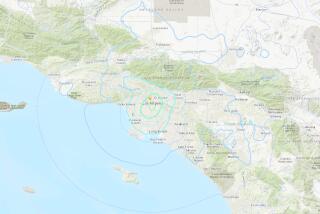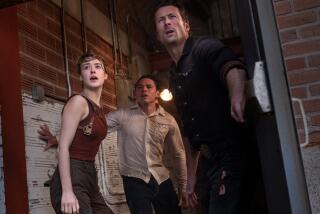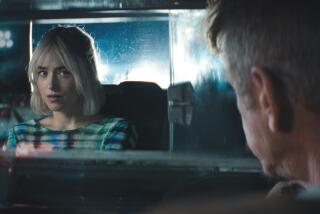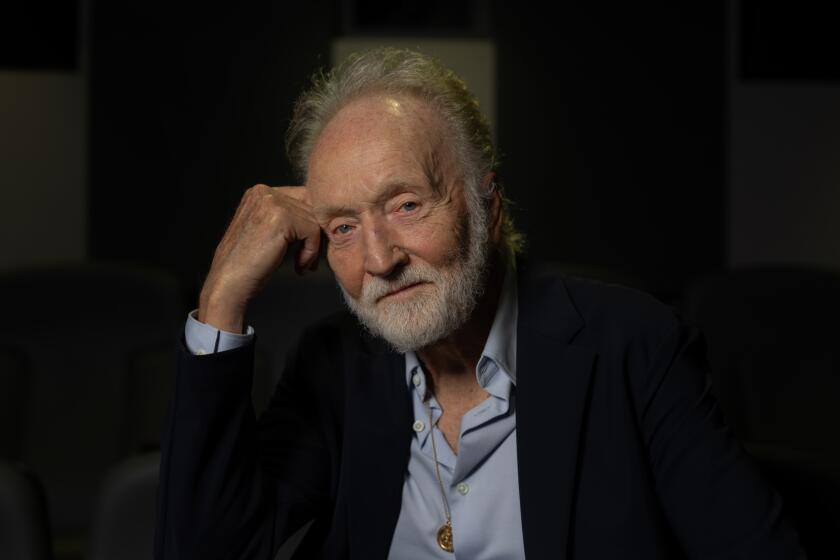‘San Andreas’ leaves critics shaken, not stirred
Poor California gets split in half by seismic activity in “San Andreas,” director Brad Peyton’s earthquake thriller starring Dwayne Johnson, Carla Gugino and Alexandra Daddario.
Not unlike the Golden State itself, film critics have also been divided by the disaster flick: Some appreciate its unabashed spectacle, but others can’t get past its CGI sheen and wooden dialogue.
In an ambivalent but somewhat favorable review, The Times’ Kenneth Turan writes, “‘San Andreas’ has the technical might to make the post-quake horrors it depicts all too plausible.” On the other hand, the movie is “woefully by-the-numbers from a dramatic point of view. Even by the non-Olympian standards of the disaster genre, ‘San Andreas’ is chock-full of cliche characters, staggering coincidences and wild improbabilities. And its dialogue is so of the ‘this is gonna hurt’ variety that I tallied close to half a dozen ‘Oh, my Gods’ before I stopped counting.”
And yet, Turan writes, “films this preposterous can be engaging if you know what you’re getting in for, especially if they have the advantage of Dwayne Johnson, once known as the Rock, in the starring role.”
The Boston Globe’s Tom Russo similarly says, “For all the unabashed cliches and straight-faced silliness delivered by Johnson, Paul Giamatti, and their generally capable castmates, they’re doing something right. The spectacle they put together with director Brad Peyton … does get us pulling for these folks to make it out of the rubble OK.”
Russo adds, “As ever with this genre, being able to compartmentalize concerns about questionable taste is an audience prerequisite. … But there’s no denying the images are darkly spectacular.”
Less impressed is USA Today’s Brian Truitt, who says that “the cringeworthy dialogue and unmoving earnestness are the biggest disasters in this mostly forgettable action flick.” As leading man, “Johnson does what he can with the material, though no one is helped by Carlton Cuse’s ham-fisted script. Many of the lines are met with a thud, and the worst of them induce groans and laughs. … Even for Rock fans and disaster-movie nerds, ‘San Andreas’ is unlikely to move anyone in any real seismic way.”
Some reviewers are complaining about the film’s blase approach to destruction.
L.A. Weekly’s Amy Nicholson says, “‘San Andreas’ can’t wait for the carnage. The problem is, it’s too chicken to ask us to comprehend it. It’s all big, distant, unfathomable wreckage — all shattering skyscrapers and rippling cityscapes — with no sense of the human cost. Even Gareth Edwards’ ‘Godzilla’ knew to zoom in on a desperate dog once in a while. … But ‘San Andreas’ wants the applause without the tears, offering no emotional impact, just cool shots of streets splintering apart.”
And the New York Times’ A.O. Scott adds, “The most disturbing thing about [the devastation] may be how dull and routine it seems. Computer-generated imagery can produce remarkably detailed vistas of disaster — bridges and buildings collapsing; giant ships flung onto urban streets; beloved landmarks pulverized — but the technology also has a way of stripping such spectacles of impact and interest. And we have seen so many of them recently that it’s hard not to shrug, stifle a yawn and reach for the popcorn when the Golden Gate Bridge once again buckles and sways and drops vehicles into the bay.”
Still, a fair share of critics seem content to sit back and enjoy the ride — though perhaps with an occasional eye-roll.
The Chicago Tribune’s Michael Phillips, for example, calls “San Andreas” a “fairly entertaining weapon of mass destruction reminding us that life’s blessings come to those who receive preferential billing.” Cuse and Peyton “respect the essential hypocrisy required by any half-decent disaster movie. Thousands may die anonymous painful deaths, but as long as we give a damn-ette about the fates of the central characters, then we can forget about the community at large.”
All in all, Phillips admits, “I enjoyed large chunks of ‘San Andreas,’ largely because the actors give it a full load of sincerity, and there’s some bizarrely effective comic relief thanks to Hugo Johnstone-Burt and Art Parkinson as Brits who picked the wrong week to visit the Bay Area.”
Follow @ogettell for movie news
More to Read
Only good movies
Get the Indie Focus newsletter, Mark Olsen's weekly guide to the world of cinema.
You may occasionally receive promotional content from the Los Angeles Times.










